After Valencia – What’s Next?
After a few days in Valencia, we both decided that the city was pleasant and wouldn’t mind extending our stay. Unfortunately, our Airbnb wasn’t available for a second week (all these obstacles to spontaneity!), so since we were going to have the hassle of packing up and moving, we might as well move on to another town rather than to a second apartment in Valencia. We thought about Alicante, about an hour down the coast by train, but we’d just visited there on the cruise and while a week at the beach would be nice, we would be even more isolated on the rail network. We really wanted to visit Granada, but since Valencia is way out on the eastern coast of Spain, the train connections to Granada were daunting. We looked at airfare, but it would have been expensive.
Another option was to take the high-speed AVE train to Madrid and possibly visit some nearby towns there, but we will be back in Madrid in October, before our flight back to the US. After going back and forth, we discovered an AVE train directly from Valencia to Seville, taking 3 ½ hours. Ann wanted to visit, Ian wanted to go to nearby Jerez de la Frontera (more on this a bit later), problem solved. As a bonus, Granada would be an easy train ride from Seville. Searching for accommodation in Seville yielded prices almost as high as Barcelona, so we opted for only three nights.
Valencia to Seville
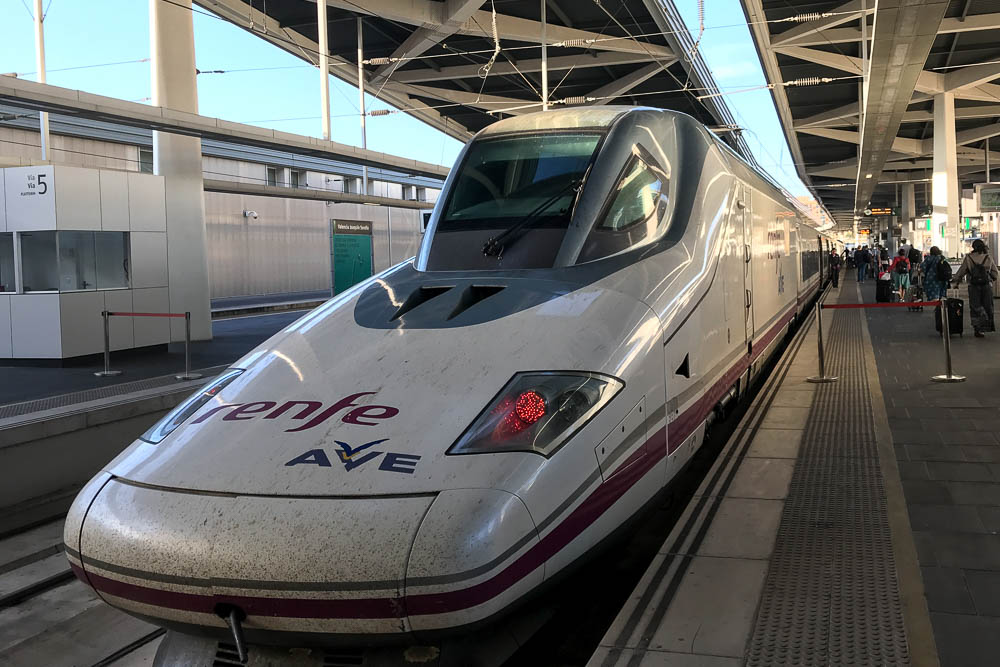
Our 3 ½ hour AVE topped out at 287 kph, smooth and quiet with scenery that was kind of boring, in a word: transportation. Our Airbnb was $78 dollars a night and located about a 20-minute walk from the main Santa Justa train station.
Exploring Seville
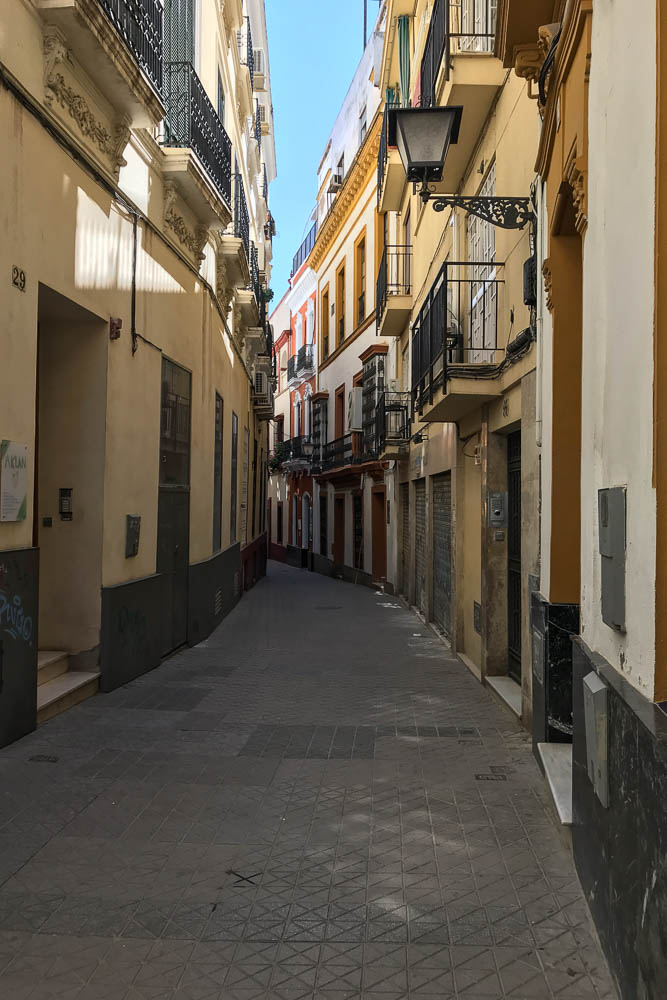
Our Airbnb host gave us a guide (written by his friend) to tapas in Seville, which we tried to follow without much luck. We are not sure if it was the directions given or issues we were having navigating streets and finding addresses in Seville. We found other places to try and enjoyed some of the local specialties, such as carrillada de cerdo, pork cheeks in a sauce (sometimes with some vegetables), which we ordered more than once.
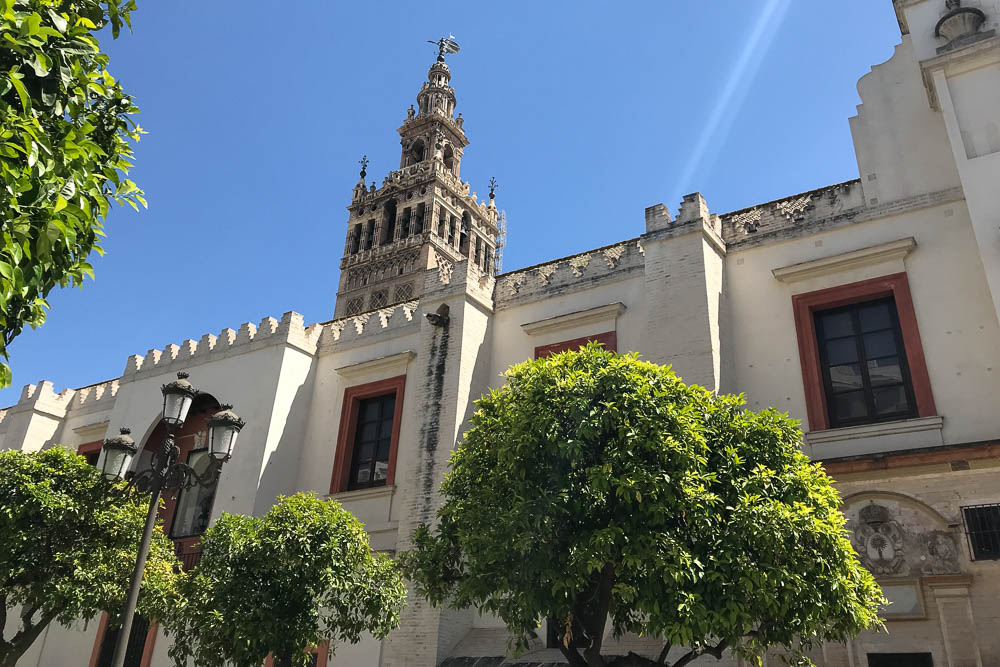
Our host also recommended (and phoned and booked for us) a flamenco show at the Flamenco Museum, a facility created to preserve traditional flamenco. The auditorium at the museum is a small venue, seating 120, but we think we were part of an overflow crowd relegated to the basement of the museum, seating about 50, making for an even more intimate experience. The 25 € (included a drink) one-hour show was fantastic, with talented dancers, singers, and especially the guitar player. Interestingly, the singing that accompanies flamenco has a Middle Eastern sound to it, probably because of the long Moorish occupation of the region of Andalusia in the south of Spain. This performance was the highlight of our time in Seville.
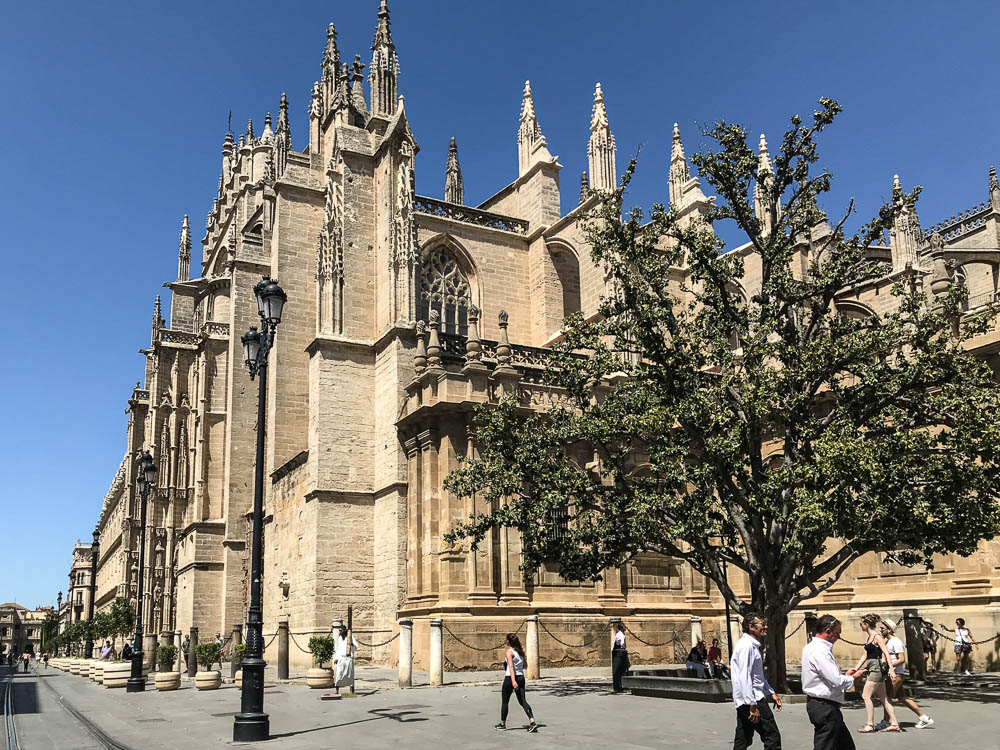

Ann wanted to do a walking tour of the old Jewish Quarter, now an expensive neighborhood, which was quite enjoyable. Surprisingly, we learned that the Jews in Seville were massacred in 1392, as the new bishop viewed them as having too much influence over the king. This horrific event occurred a full 100 years before the Jews were kicked out of the rest of the country.


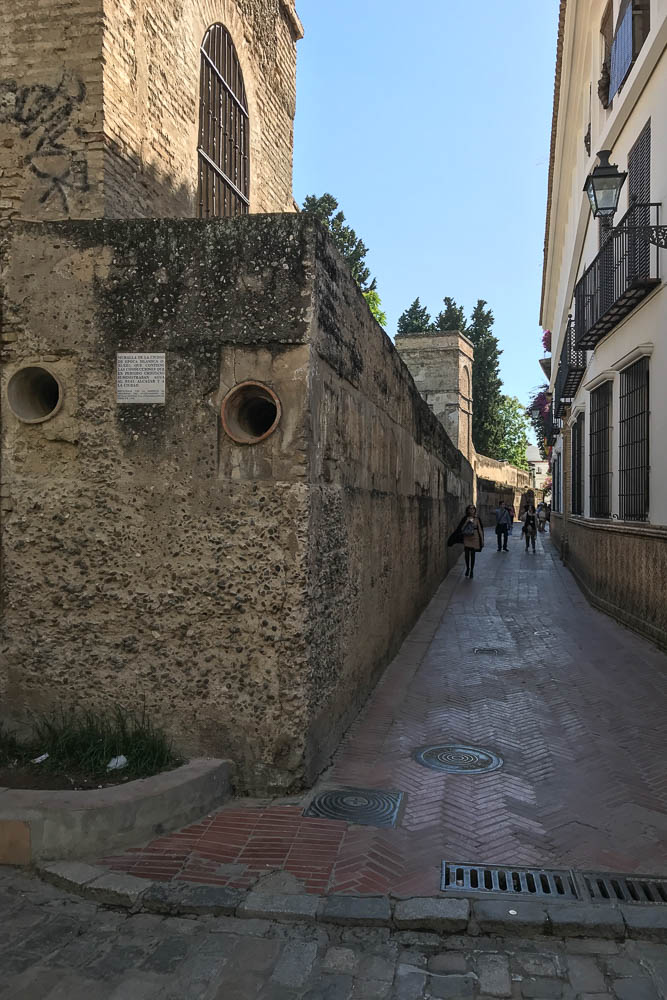
We also visited the must-see attraction in Seville: the Alcazar, the former Moorish Palace turned royal residence when Ferdinand and Isabela retook Seville.

We bought our tickets online the day before, allowing us to skip the lines, a very good thing since the lines are capacity controlled and move slowly; it’s not unheard for people without tickets to wait for hours. Tickets displayed on phones are fine for admission.



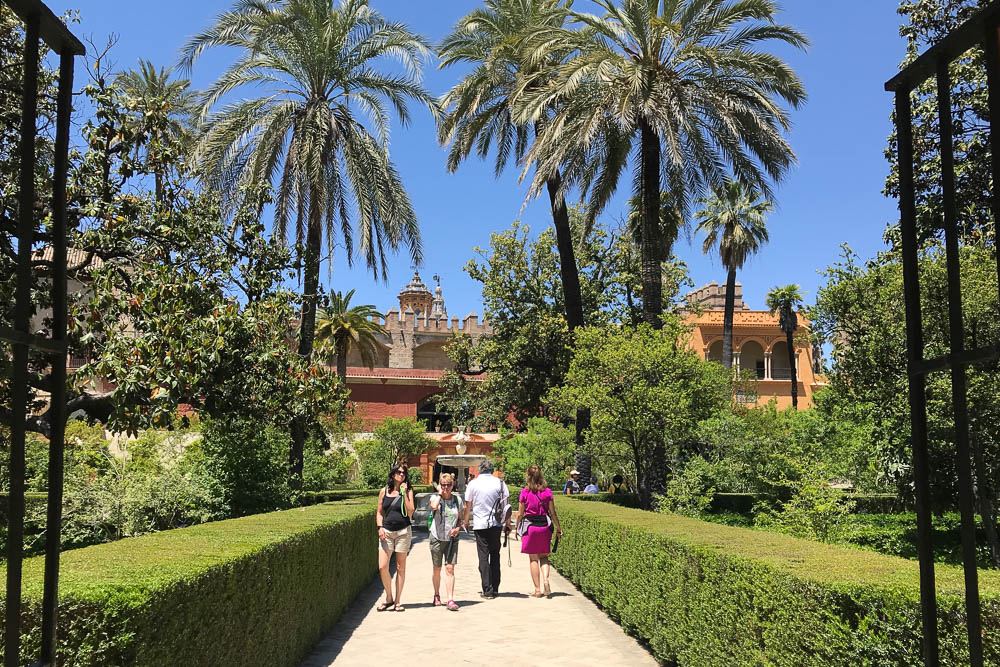
While impressive, Ann enjoyed the visit more than Ian, who had been there before so was a little bored.
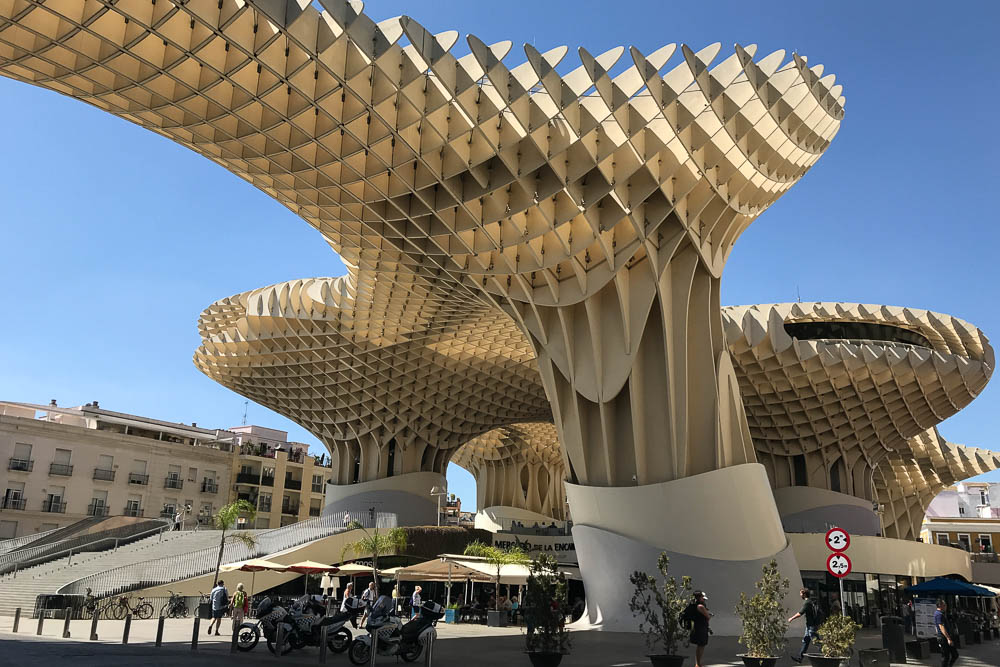
We spent the rest of our time in Seville simply wandering around the town, ducking into back alleys as the mood fit.
Jerez de la Frontera

After visiting Porto a few years ago on a trip to Portugal and becoming enlightened about port, we wanted to round out our knowledge of the big two fortified wines by learning about sherry.

Herein lies the truth as to why Ian was okay with going to somewhat more expensive Seville (he’d been there before).
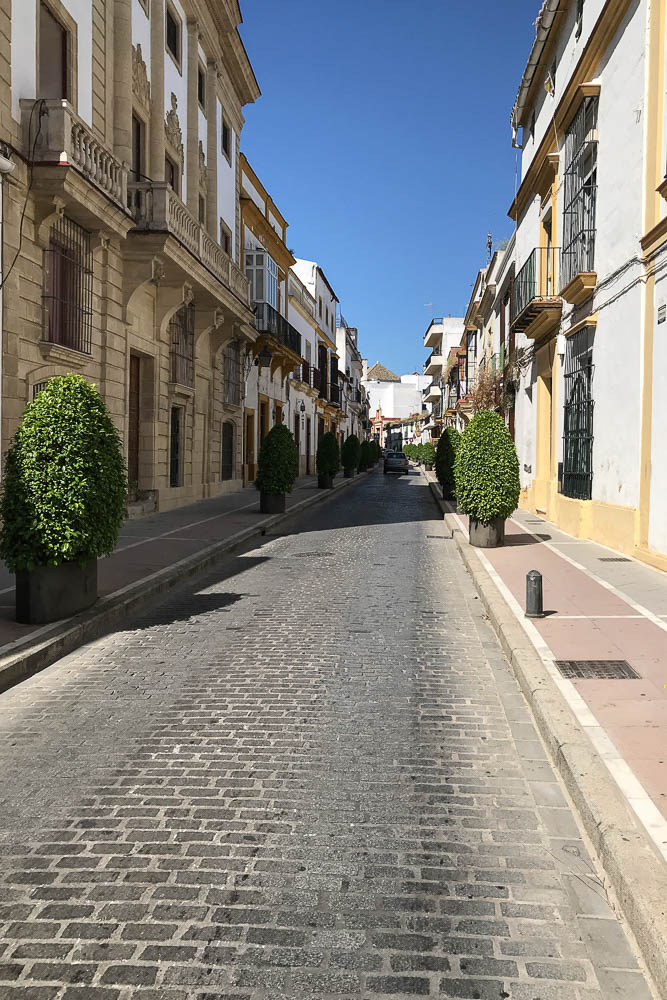

Jerez, the sherry capital of Spain and possibly the world, is a 1-1/2 hour train ride from Seville. The city is also known as the city of flamenco, horses, and motorcycles.

Ian had done some research ahead of time and decided we should do the full 1 ½ hour tour with tasting at Lustau, a producer of top quality sherries.

Their current property was bought when Harveys (of Harveys Bristol Cream fame) decided to reduce the size of their bodega. It’s an impressive setup with many bodegas (aging rooms) holding various kinds of sherries. The rooms are kept cool, using ventilation from windows, heavy stone walls, and concrete floors.

On the tour, we walked through all of the rooms, learned how sherry is made, and then tasted nine styles of sherry as well as two vermouths.

A combination of two different processes are used to make six different kinds of sherry.
- Fino & Manzanilla – The grape juice is put into the barrel, filled about 5/6 of the way, the juice comes in contact with the air which contains flor (a naturally occurring yeast in the area), starts the fermentation process and converts the sugar to ethanol. Once the first fermentation is finished, neutral spirits are added to bring the alcohol content up to 14.5-16%, thus allowing the yeast to start a second aerobic process which reduces acids and forms a waxy film on the top of the wine which stops the wine from oxidizing. The wine is then aged for 2-10 years under the film.
- Oloroso – The process starts the same way as with fino but after the first fermentation, enough neutral spirits are added to bring the alcohol content above 16% thereby killing the yeast, which prevents a film from forming. The wine is again aged for 2-10 years but since it’s in contact with air, oxidation occurs and the wine has a very different flavor profile. This wine is still dry.
- Amontillado, Palo Cortado – These dry wines use a combination of the two techniques above to create wines that have characteristics of both.
- Cream – This is the classic sherry that comes to mind when most people think of sherry. A desert wine, which is really an Oloroso sherry sweetened with Pedro Ximenez grapes.

While neither of us was thrilled with Seville or Jerez as towns, the highlights for us were the flamenco show in Seville and the sherry tour and tasting in Jerez. As a point of information, both towns have dual bike lanes (on the same side of the street), which are more a part of the sidewalk than the road. These are more extensive in Seville, including separate bike lanes alongside pedestrian crosswalks. Seville (as well as other cities in Spain) has those bicycle rentals around town that are accessed through a cell phone app. Nearby the train station on the morning we left, we noticed that all but one of the bicycles were gone; perhaps commuters use them daily to get to and from work.
Side Note: Buying Fruits and Vegetables in Spain
- In the supermercado, select your own produce, put it in a plastic bag, place it on the scale, punch in the code, and use the sticky-backed label that is issued at the base of the scale to seal the bag.
- At fruit and vegetable stands, observe the locals; more often than not, the customer says what he/she wants, and the proprietor takes over from there.
Another side note: Ice cream cones in Spain are longer and skinnier than those in the US.
Next Up: Granada
Ian & Ann

12 Comments
When you speak Spanish in Spain, do they answer in English? That was Puerto Rico for me. Almost everyone had better English than my Spanish so it was hard to deliberately practice.
Hi Art,
Perhaps more often than not, people reply in Spanish, or sometimes a mix of Spanish and English. We think a variety of factors are involved. Some people don’t speak English; others want an opportunity to practice. People in tourist areas and attractions often reply in English; people in more local venues usually reply in Spanish. So yes, we are having opportunities to practice. Also, we’re understanding a lot more than we expected here, and definitely much more than in Colombia.
Ian & Ann
Love what/how you are going. You guys are doing so many great and interesting things. We should hang with you guys, you do a lot more than we!!!
Hi Joan,
We’d love to have you guys hang with us. But you actually do a lot more than you realize; you’ve just been doing it for so long that it’s become somewhat routine. Actually, you guys have been a big part of our inspiration.
Ian & Ann
Just read and loved your blog. I m semding this from my phone. Beautiful and colorful buildings and walking areas. Interestimg story history about thr Jewish people. Love
Hi Norma,
Wow! We’re impressed! Commenting from your phone, you’re really coming up in the world.
Ian & Ann
We love following your trip especially since we are so close , right now we are in Seville and want to thank you for your suggestion going to,the Flaminco museum, loved it. On our way to Ronda then Granada, any suggestions there?
Hi Michelle,
Glad you got to enjoy the Flamenco Museum. We didn’t go to Ronda, we really liked Granada (that post out soon). Suggestions: of course, the Alhambra (if you don’t have tickets, get them NOW, https://tickets.alhambra-patronato.es/en/) tapas in the central mercado, the Albaicin (old Moorish neighborhood), the Royal Chapel. Have fun! Enjoying following your Spain travels on FB,
Ian & Ann
We’re leaving for Spain soon. We go back and forth taking advantage of their amazing and affordable public transportation system and lower cost of living to visit different parts of it. Thank you for your your recommendations.
People tend to skip Murcia region and it’s Costa Cálida. Mar Menor, La Manga del mar Menor and the Mediterranean viewed from the city of Lo Pagan is a wow. Of course, Mar Menor ( Minor sea, a big pool for non swimmers like myself) ) has been on the bad side of the news lately due to pollution.
Sometime next year, the Ave train will connect to Murcia. I think people will then visit Murcia more, known for its agricultural, fresh diet. Love reading anything about Spain, raises my energy. Thank you.
Thanks for the tips, Micaela. We have never heard about the Costa Calida area before but will put it on our list on our next trip to Spain. The closest we have been is Alicante. What time of the year is best for this area?
Ian & Ann
As the name “Cálida” implies, it’s very hot in the summer. I wouldn’t there go the months of June, July August. Besides, July and August, Spanish residents vacation months, you not only encounter “Big red”☀’s heat but the vibrational heat of thousands of humans saturated in one spot.
Best months to be in Costa Cálida: March – June, Sept – Nov. You can experience Mud Baths at the salinas ( Free of charge, only in Spain) visit La Manga del Mar Menor, a mind boggling peace of land in between Mar Menor sea and the Mediterranean sea. Take a ride to El Mojón(Murcia) literally across the street from El Mojón (Alicante) And while you’re there stop at The Corner where the locals hang out with their local law enforcement (Only in Spain)
And while in Lo Pagan, try the yummy cooking of Domingo El Portugués Restaurant, very reasonable. Then Rubio 360 restaurant a little on the expensive side but with a five stars view. And why not hang out a little with the locals in the little fishing town called San Pedro del Pinatar, next to Lo Pagan, totally inexpensive. And if you happen to be in that area on a Monday, attend the Mercadillo in San Pedro, please. Sooo much fresh fruit and vegetables and soooo cheap! There’s another Mercadillo in Lo Pagan on Thursdays I think. fo
For 10 euros or less you can eat fresh fruit and vegetables (Straight from the farm) for 1 WEEK!
I think it’s Homer who said something like: The Journey is it’s own reward. I can’t recall the exact quote and don’t have time to Google. But I think what he meant was Enjoy, Life is Good!
Hi Micaela,
Wow! Awesome tips! Looks like there just might be a return visit to Spain, to new places for us, in our future!
Ian and Ann